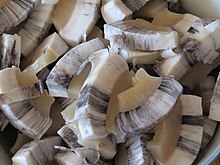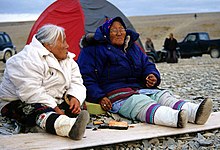Muktuk

Muktuk[1] is a traditional Inuit and Chukchi food consisting of frozen whale skin and blubber.

Muktuk is most often made from the skin and blubber of the bowhead whale, although the beluga and the narwhal are also used. Usually eaten raw, today it is occasionally finely diced, breaded, deep fried, and then served with soy sauce. Despite it being usually eaten raw it could also be eaten frozen or cooked.[2] It is also sometimes pickled.[3] When chewed raw, the blubber becomes oily, with a nutty taste; if not diced, or at least serrated, the skin is quite rubbery.
In Greenland, muktuk (mattak) is sold commercially to fish factories,[4] and in Canada to other communities (muktaaq).[5]


Muktuk has been found to be a good source of vitamin C, the epidermis containing up to 38 mg per 100 grams (3.5 oz).[6][7] It was used as an antiscorbutic by British Arctic explorers.[8] Blubber is also a source of vitamin D.[9]
As whales grow, mercury accumulates in the liver, kidney, muscle, and blubber, and cadmium settles in the blubber.[10] It also contains PCBs, carcinogens that damage human nervous, immune and reproductive systems, bioaccumulated from the marine food web,[11][12] and a variety of other contaminants.[13]
Spellings[]
- Ikiilgin, Chukchi
- Maktaaq (ᒪᒃᑖᖅ), Siglitun, Kivalliq, Aivilik, North Baffin, East Baffin, South Baffin[14]
- Maktak (ᒪᒃᑕᒃ), Inupiat,[15] Siglitun, North Baffin[16]
- Maktaq, Inuinnaqtun,[17] Natsilingmiutut (Inuvialuktun)[18]
- Mattak, Labrador, Greenland[19]
- Mangtak, Alaskan Yup'ik[20]
- Mungtuk, Siberian Yupik
- Kimaq, Alutiiq/Sugpiaq
In some dialects, such as Inuinnaqtun, the word muktuk refers only to the edible parts of the whale's skin and not to the blubber.[17][21]
See also[]
References[]
- ^ "muktuk". Asuilaak Living Dictionary.
- ^ Stern, Pamela (2009). The A to Z of the Inuit. Lanham: Scarecrow Press. p. 101. ISBN 978-0-8108-6822-9.
- ^ "10 Weirdest Foods in the World". News.travel.aol.com. 9 September 2010. Retrieved 11 September 2013.[permanent dead link]
- ^ Heide-Jørgensen, Mads Peter (January 1994). "Distribution, exploitation and population status of white whales (Delphinapterus leucas) and narwhals (Monodon monoceros) in West Greenland". Meddelelser om Grønland, Bioscience. 39: 135–149.
- ^ Hoover C, Bailey M, Higdon J, Ferguson SH, Sumalia R (March 2013). "Estimating the Economic Value of Narwhal and Beluga Hunts in Hudson Bay, Nunavut". The Arctic Institute of North America. 66: 1–16.CS1 maint: uses authors parameter (link)
- ^ Geraci, Joseph R. & Smith, Thomas G. (1979). "Vitamin C in the Diet of Inuit Hunters From Holman, Northwest Territories" (PDF). Arctic. 32 (2): 135–139. doi:10.14430/arctic2611. JSTOR 40508955.
- ^ Fediuk, K.; Hidiroglou, N.; Madère, R.; Kuhnlein, H. V. (2002). "Vitamin C in Inuit Traditional Food and Women's Diets". Journal of Food Composition and Analysis. 15 (3): 221. doi:10.1006/jfca.2002.1053.
- ^ McClintock, Francis Leopold (2012), "CHAPTER XVI", A Narrative of the Discovery of the Fate of Sir John Franklin and His Companions, Cambridge University Press, pp. 301–322, doi:10.1017/cbo9781139236522.018, ISBN 978-1-139-23652-2
- ^ Kuhnlein, H. V.; Barthet, V.; Farren, A.; Falahi, E.; Leggee, D.; Receveur, O.; Berti, P. (2006). "Vitamins A, D, and E in Canadian Arctic traditional food and adult diets". Journal of Food Composition and Analysis. 19 (6–7): 495. doi:10.1016/j.jfca.2005.02.007.
- ^ Wagemann, R.; Snow, N.B.; Lutz, A.; Scott, D.P. (1983). "Heavy Metals in Tissues and Organs of the Narwhal (Monodon monoceras)". Canadian Journal of Fisheries and Aquatic Sciences. 40 (S2): s206–s214. doi:10.1139/f83-326.
- ^ "Chemical Compounds Found In Whale Blubber Are From Natural Sources, Not Industrial Contamination". 18 February 2005.
- ^ "Japan warned on 'contaminated' blubber". BBC News. 24 January 2001. Retrieved 31 December 2009.
- ^ "Google Scholar". scholar.google.com. Retrieved 18 November 2018.
- ^ "maktaaq". Asuilaak Living Dictionary.
- ^ Uqaluktuat: 1980 Elders' Conference, Women's Session ISBN 1-881246-01-9
- ^ "maktak". Asuilaak Living Dictionary.
- ^ a b Ohokak, G.; M. Kadlun; B. Harnum. Inuinnaqtun-English Dictionary (PDF). Kitikmeot Heritage Society. Retrieved 3 April 2016.
- ^ "maktaq". Asuilaak Living Dictionary.
- ^ "mattak". Asuilaak Living Dictionary.
- ^ Jacobson, Steven A. (2012). Yup'ik Eskimo Dictionary, 2nd edition. Alaska Native Language Center.
- ^ "edible whale skin". Asuilaak Living Dictionary.
External links[]
| Wikimedia Commons has media related to Maktaq. |
| Look up muktuk in Wiktionary, the free dictionary. |
- Inuit cuisine
- Chukchi cuisine
- Yakut cuisine
- Whale dishes
- Animal fat products
- Canadian cuisine